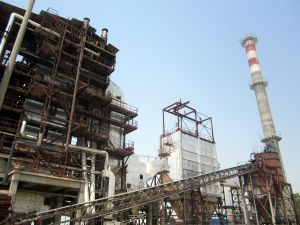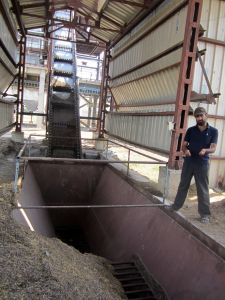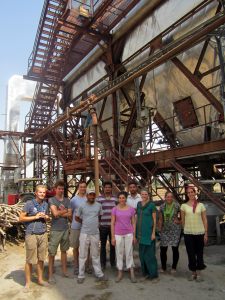Recently, the interns involved in the Biogas Workshop held in Himachal Pradesh were treated to an extra day of field visits related to renewable energy in Punjab. The biomass plant visit was among the many highlights of this extended workshop.
Located near Nakoda, the Green Planet Energy Ltd Biomass Plant produces 7,000 kilowatts of energy per hour (KWh). Assuming the average house utilizes 3 KWh, this one plant produces enough energy to power 2,333 homes every hour. All of this energy is produced through the burning of biomass (organic) waste that would otherwise be burned in farm fields.
Full view of the biomass plant with the boiler on the left
Benefits of the Biomass Plant:
- Alternative to burning biomass in fields, causing air pollution
- Saves habitat and ground cover
- Produces renewable energy – 2 KG biomass = 1 KW energy
- Gives extra income to farmers – 1 rupee = KG of hay or biomass
Biogas Plant Process:
- Farmers sell biomass waste to the plant
- Biomass is dried and compacted
- Compacted biomass is loaded onto the belt, leading to the furnace (see Photo 2)
- Biomass is used as fuel in boiler, reaching temperatures of 700 degrees Celsius
- Boiler heats 30 tons of water each hour (of which 2 tons evaporates, 28 tons reused)
- The boiling water creates steam
- Steam runs the turbine at 7500 revolutions per minute (RPM)
- Turbine produces electricity/power by running the generator
Compacted biomass is loaded onto a belt leading to the boiler
Waste Products/Emissions from Biomass Plant Processes:
Of course, burning the biomass fuel creates waste fumes. The fumes contain particles of carbon monoxide, a poisonous gas for humans to breathe, and carbon dioxide, a greenhouse gas widely considered to be contributing to global warming.
The workshop team in front of the electric static precipitator (from left to right: Clement, Adrien, Owen, Gulshan, Biomass Plant Engineers, Ariel, Katrina, Mandy, and Sevil)
The Electric Static Precipitator (ESP) presents a solution to this environmental waste dilemma. The ESP processes the gases from the boiler with charged electrodes.
These electrodes attract the harmful particles in the fumes, releasing clean oxygen and solidifying the carbon particles into ash.
The ash is then used in building materials, such as bricks and roads. 99.4% of the harmful gases are collected through this ESP process.
After a full day of field visits, it was not only a highlight, but also a privilege to be shown the inner workings of this biomass plant.
By Katrina Sill, USA


